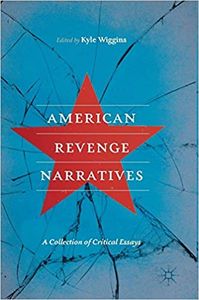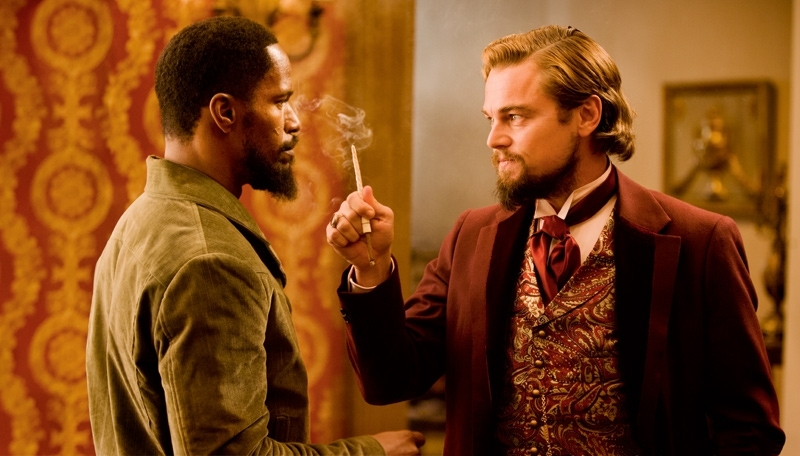From Toni Morrison to Tarantino–Analyzing America’s Vengeful Stories
 Kyle Wiggins’ new book, American Revenge Narratives: A Collection of Critical Essays (Palgrave MacMillan, 2018) is a compilation of essays examining post-war American revenge stories and “the nation’s love for vengeance.” The essays explore both film and novels—from Toni Morrison’s Beloved to Steven Spielberg’s Jaws—as they contend with our country’s “seemingly inexhaustible production of vengeful tales.” Wiggins, a lecturer of rhetoric at Boston University College of General Studies, spoke with CGS about the book and the modern American revenge story.
Kyle Wiggins’ new book, American Revenge Narratives: A Collection of Critical Essays (Palgrave MacMillan, 2018) is a compilation of essays examining post-war American revenge stories and “the nation’s love for vengeance.” The essays explore both film and novels—from Toni Morrison’s Beloved to Steven Spielberg’s Jaws—as they contend with our country’s “seemingly inexhaustible production of vengeful tales.” Wiggins, a lecturer of rhetoric at Boston University College of General Studies, spoke with CGS about the book and the modern American revenge story.
BU College of General Studies: Your book description references American’s “vengeful storytelling tradition.” In some sense, the revenge story is universal and timeless—so what makes a revenge narrative uniquely “American”?
Kyle Wiggins: It’s true, revenge is one of the oldest narrative themes. However, American revenge narratives, especially those that emerge after World War II, often break the genre’s conventions in at least one of three ways:
- American avengers don’t always follow a “code” of proportionality. They shed blood indiscriminately and without limit on their vengeance.
- Vengeful characters exhibit an addiction to getting even. Their retributive behavior brings no relief or closure, so they keep retaliating out of compulsion. In many American novels or films, revenge functions like an inexhaustible desire. That is a significant tendency since it renders one of the revenge genre’s basic plot points – satisfaction – unreachable.
- American avengers often seek payment from systems (like capitalism or the drug trade) rather than human antagonists. These characters have grievance with massive, abstract enemies, and struggle to find ways to get even with them.
Though relatively young, compared to Attic tragedy or Elizabethan drama, the American revenge tradition has already started to birth archetypes. You might consider characters like Dexter, who can’t stop killing serial killers that evade the limited reach of law, or John Smith from Sherman Alexie’s Indian Killer. John yearns to murder the one white man who is responsible for all that has gone wrong for Native Americans. Both characters are quintessential American avengers, and delusional about their violent quests, albeit for different reasons.
CGS: The essays in the book touch on cinema and literature, war, racism, misogyny—even animals as “agents of nature’s revenge.” How did you decide which themes were important to include in the book?
KW: Part of the revenge genre’s appeal is its versatility. It can dramatize small feuds between neighbors or large clashes between warring ideologies. But no matter its scale or context, revenge – as a plot – dangles the possibility of correction. Wrongs may get righted, balance may be restored. And because readers and viewers love seeing characters get what they deserve, revenge narratives have opportunities to issue powerful statements to a receptive audience about different types of world injustice. Including chapters that discussed the many targets of vengeful desire made sense.
More specifically, I wanted to show how popular and nuanced revenge has become in contemporary culture. To support the book’s claim that vengeance is one of the abiding post-war American themes and a major means of political critique, I needed chapters that show revenge put to diverse (and sometimes surprising) ends. So I sought out essays on ecological vengeance, indigenous or Native American retribution, feminist payback cinema, and the war on terror. The chapters that people submitted blew me away, and do a marvelous job demonstrating revenge’s deep infiltration into the American imaginary.

CGS: In your chapter, “The Modern American Revenge Narrative,” you look at a modern transformation of the revenge narrative—a character’s impulse to “shape vengeful desire into something useful.” Instead of taking on an entire, evil system, the character channels their rage toward a single person who represents that system. Why do you think the revenge narrative changed in this way?
KW: Revenge narratives modernized, in part, because of recognition that injustice is complex. The art form matured. Crime and inequality have diffused sources. Yet, it would be unwieldy in a novel, for instance, to depict an environmental crusader poisoning every shareholder, board member, employee, supplier, and bankrolled politician who made it possible for a chemical treatment facility to contaminate the water table. So, modern revenge characters select proxies, character stand-ins who represent the chemical treatment facility’s policies but aren’t singularly responsible. It’s a kind of convenient but necessary symbol-making that takes place within the plot itself.
Modern revenge stories walk a tightrope. They have to acknowledge the complexity of guilt in an interconnected world yet provide audiences the basic delight of bad people getting their just desserts. Because of that tension, revenge plots are especially thrilling right now. They imagine an improbable fairness in which the wicked are harshly punished and swift violence sorts out the world’s messy problems. If it’s a comforting fiction, it’s also a deeply unsettling one.
CGS: You include Quentin Tarantino in your analysis, and it’s easy to see how some of his recent movies, like Django Unchained for example, fit with the point you’re making.
KW: Tarantino is tricky to discuss because his recent movies (Inglorious Basterds, Django Unchained, and to a lesser extent Kill Bill vol. 1 & 2) involve a heavy dose of fantasy. Tarantino indulges a kind of wish-fulfillment – to see slave plantations detonate in fiery righteousness and Nazis immolated in a theater – that can only occur in the alternate space of fiction/film. His movies wear their irony proudly and invite the audience to enjoy the spectacular violence. There’s an inside joke register to them.
CGS: There was a lot of cultural debate about those themes when the movies came out. What do you think of the debate about these revenge stories?
KW: When Django Unchained and Inglorious Basterds debuted there was a lot of controversy surrounding their levels of gore. People accused them of excess. Others worries about the films’ tone. Essentially critics asked: what does it mean for these movies to shed so much blood and make jokes about killing Nazis and plantation owners at the same time? Should audiences enjoy these on-screen massacres? Django and Inglorious Basterds were too graphic and transformed too much painful history into entertainment.
That particular debate, as far as it concerns Tarantino, isn’t very interesting to me. For starters, it misses the way Tarantino deconstructs the revenge genre. Despite their other issues, his films smartly mock how audiences crave punishment more than prevention, how vengeful satisfaction seems proportional to original suffering, and how aesthetic violence horrifies and delights simultaneously. But really, I view his films as thought exercises in how art is a method of dreaming up unlikely justice.
CGS: In your own chapter, you look at both novels—by Thomas Pynchon, E.L. Doctorow, and Elizabeth Stuckey-French—as well as films by Robert Siegel and Quentin Tarantino. Why did you think it was important to include both cinema and literature in your own analysis, and in the book as a whole?
KW: When we think about stories the nation tells about itself, and the centrality of vengeance to those stories, it’s reasonable to consider as many types of narrative as possible. Too often conversations about art happen in isolation. We only discuss the way poetry treats a given theme, or the way new media uses a particular motif. Scholars who contributed to this volume do a great job, collectively, charting shifts in American attitudes toward vengeance (and justice) that play out on the page and screen. That said, there is a lot more work to be done understanding the nation’s fascination with vengeance. I think of this book as a first reckoning.